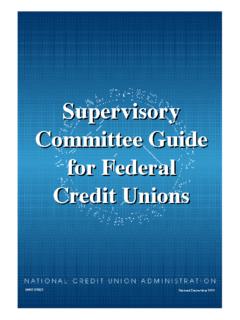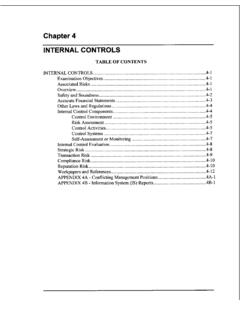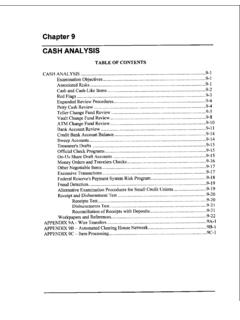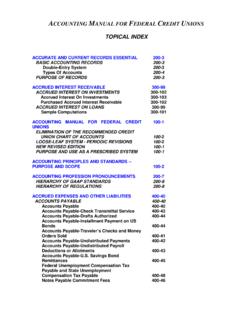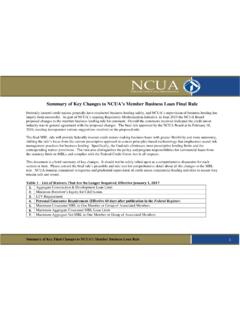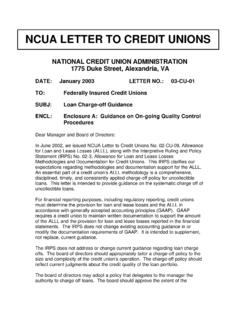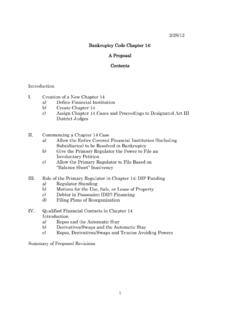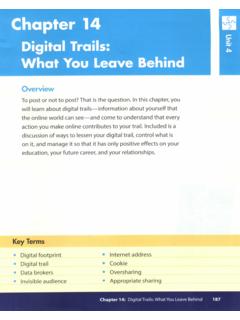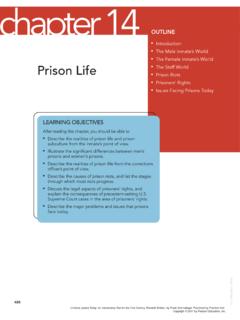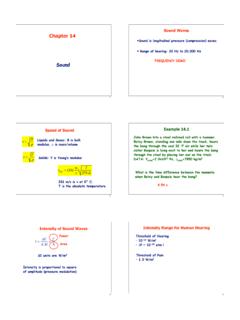Transcription of Chapter 14 SHARE STRUCTURE
1 Chapter 14 SHARE STRUCTURE TABLE OF CONTENTS SHARE STRUCTURE .. 14. 1 Examination Objectives .. 14. 1 Associated Risks .. 4-1 Overview .. 14-1 Examination Procedures .. 14-2 SHARE Draft Programs .. 4-2 Operational Flow .. 14-3 Sound Operation .. 14-3 Overdrafts .. 14-3 Verification .. 14-4 Fees .. 4-4 Business SHARE Accounts ..l 4-4 Fraud and Forgery .. 4-5 Internal Control STRUCTURE .. 14-5 Advertising and Disclosures .. 4-6 Workpapers and References .. 14-7 APPENDIX 14A - TYPES OF SHARE ACCOUNTS .. 14A-1 APPENDIX 14B - SHARE ACCOUNT RED FLAGS .. 14B-1 Chapter 14 ~ ~~~~ SHARE STRUCTURE Examination 0 bjectives 0 Associated Risks Overview Determine whether the credit union has a realistic SHARE product mix and pricing policy Determine whether the SHARE program meets the needs of the members Analyze the SHARE mix to determine whether it provides for adequate earnings Determine whether the SHARE program incorporates adequate internal controls Evaluate the reasonableness of fluctuations in the shares and SHARE mix Determine whether the SHARE program meets all legal requirements Interest rate risk - improper pricing of products constitutes the leading cause of interest rate risk.
2 Liquidity risk - improper pricing and poorly timed duration can cause liquidity risk; Reputation risk - improper pricing and product mix, and illiquidity can result in reputation risk; Strategic risk - ineffective planning of the SHARE product mix and pricing policies can result in strategic risk; Credit risk - allowing members to overdraw accounts can result in credit risk to the organization; Transaction risk - improper transaction processing and controls of SHARE account types and processing failures can cause other risks ( , interest rate risk, liquidity risk); and Compliance risk - inadequate or ineffective compliance policies regarding account disclosures for interest rates, yields, or terms can result in loss exposure.
3 SHARE accounts are the primary source of funds for credit unions. As such, the SHARE program should conform to the credit union's asset liability management policies. In determining the proper SHARE mix, the credit union must consider the cost of funds, the matching of funds Page 14-1 EXAMINER'S GUIDE with corresponding assets, and the needs of the members. Management must monitor the SHARE STRUCTURE and make appropriate changes in a timely manner when needed. The extent of the examiner's analysis depends on the complexity of the credit union's SHARE STRUCTURE . The examiner considers such factors as the following: 0 SHARE policies ( , terms, dividend rates, fees, etc.)
4 ; and Effect of the SHARE policies on net income, short- and long-term goals, and funds management. When examiners have concerns with the SHARE program, they should perform sufficient procedures to address and resolve their concerns. Examination Procedures Most information systems provide management reports at the end of the members' trial balance. Although the number and types of reports vary with each information system, these reports should enable the examiner to verify the SHARE account balances and confirm the breakdown of SHARE types. SHARE Draft Programs Examiners may review SHARE draft programs to determine the extent of the credit union's control over SHARE draft processing, balancing, and posting.
5 Credit unions must promptly (at least daily) review and process overdrafts and related loan advances, and clear processing exceptions. Examiners should expand their analysis when they encounter or have reason to suspect material risk factors. Material operational problems ( , out-of-balance individual SHARE draft ledgers, failure to promptly post SHARE drafts, out-of-balance bank settlement accounts, and lack of proper control over overdraft activity including exception processing) can prevent a credit union's SHARE draft program from functioning properly. Because SHARE draft programs involve third parties, a credit union's failure to properly maintain internal operations over this program could damage its reputation resulting in increased reputation risk.
6 Delays in processing drafts received for payment can increase credit risk and result in material losses. Page 14-2 SHARE STRUCTURE Operational Flow With SHARE draft programs, members write drafts and present them to third parties, who present the drafts received to their own banks. The payee's bank forwards the drafts through bank clearing channels for presentation to the credit union's payable-through bank. The payable- through bank receives the drafts and makes provisional payment subject to payment or dishonor by the credit union. Upon receipt of the drafts, the payable-through bank presents the information on the drafts to the credit union. Normally, the payable through bank converts the information on the SHARE drafts to an electronic medium (magnetic tape) transmits it to the credit union for payment or dishonor (the bank may also transmit the information directly to the credit union's information system process supplier.)
7 The credit union then approves payment and posts the SHARE withdrawals to the members' accounts. Sound Operation It is the board of directors' responsibility to establish sound operational and internal control procedures to safeguard the integrity of a SHARE draft program. A credit union should obtain a written legal opinion that the program not only conforms with federal law and regulations, but also any state law requirements or other requirements, such as clearing house rules. A credit union may use its own routing and transit number (payable-at method) or the routing and transit number of the payable- through bank (payable-through method.) The board of directors should evaluate the cost and conveniences of the two methods before selecting one.
8 Overdrafts When a credit union receives a SHARE draft that overdraws a SHARE draft account, it has several options available: 0 Return the draft as not paid for lack of sufficient funds. 0 Accept the draft pending receipt of payment from the member to cover the overdraft. This is rare and usually involves small overdrafts. Credit unions should establish sufficient internal controls to prevent abuse. Accept the draft and create an overdraft, and then clear the overdraft by a transfer from another SHARE account or by an advance Page 14-3 EXAMINER'S GUIDE Verification Fees from a line of credit, special loan plan or other arrangement established with the member.
9 Credit unions that offer a line of credit for SHARE draft accounts should ensure the member signs agreement and a SHARE draft agreement. The credit union must comply with any provisions for lines of credit in the NCUA Rules and Regulations. The SHARE draft agreement may authorize the credit union to transfer the amount of loan advance to the SHARE draft account. separate agreements: a line of credit Credit union officials do not normally review the SHARE draft to determine if the member signed the draft presented. Members review the periodic statement for unauthorized drafts. If members find an unauthorized draft, they must notify the credit union. When a credit union receives notice of an unauthorized draft, the credit union should retrieve the original draft or a copy of the original draft for comparison against the signature card on file at the credit union's office.
10 The board of directors should determine that adequate insurance coverage exists for forged drafts. Credit unions offering SHARE drafts to their members may charge periodic fees or service charges to their members using SHARE drafts ( , for the distribution of interim statements, processing stop payment orders, overdrafts, obtaining copies of paid drafts for a member, and the actual cost of each member's blank SHARE drafts.) The board of directors establishes the fee structures. Business SHARE Accounts For credit unions offering business SHARE accounts, examiners should assess the materiality of these accounts on overall operations. Examiners may need to expand the scope of the examination in this area based on the following: 0 0 Numbers and amounts of the business SHARE accounts; Degree and effectiveness of internal controls surrounding these accounts; and Increased risk resulting from offering these shares .
